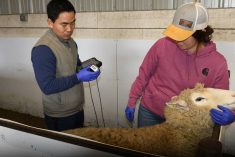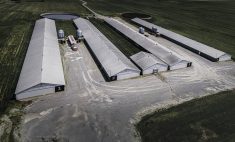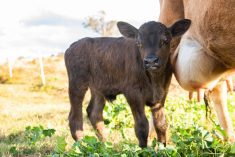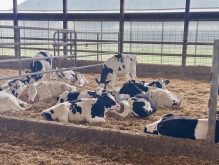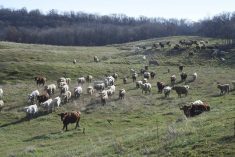Bernie Peet is president of Pork Chain Consulting Ltd. of Lacombe, Alberta, and editor of Western Hog Journal. His columns will run every second week in the Manitoba Co-operator.
Arecent roadshow in Western Australia, organized by the Pork Co-operative Research Centre (CRC), based at the University of Adelaide, featured a presentation by Dr. Jeff Downing on the possibility of eliminating the weaning-to-mating interval by inducing estrus during the suckling period and breeding sows prior to weaning.
Read Also

Pig transport stress costs pork sector
Popular livestock trailer designs also increase pig stress during transportation, hitting at meat quality, animal welfare and farm profit, Agriculture and Agri-Food Canada researcher says
While the concept is not new, the inconsistency of results in previous research in various parts of the world has meant that the principles have not been developed into commercial production systems. Now Dr. Downing believes his recent research points the way towards achieving fewer nonproductive days and more pigs weaned per sow per year.
A study carried out in 2007 had shown that estrus could be induced during lactation, using an injection of gonadotrophins (PG 600: Intervet) at 19 to 24 days after parturition, combined with boar exposure and piglet separation for 16 hours each day until mating. Dr. Downing and his colleague Roger Giles set about testing the concept under commercial conditions.
“We also wanted to test the hypothesis that induction of estrus during lactation and postponing weaning age to 35 days has no effect on subsequent mating and farrowing performance, compared to a cohort of sows weaned at 20 days after farrowing,” Downing notes. “Another hypothesis to test was that postponing weaning to 35 days after farrowing will increase piglet weight at weaning and increase growth at 70 days of age when compared to a cohort of piglets weaned at 20 days after farrowing.”
The study was conducted with 46 parity 2+ sows in conventional farrowing crates and housed in the same room. “At 20 days after farrowing the sows were treated with an injection of PG 600, combined with boar exposure and piglet separation from 16:00 hr. to 08:00 hr. each day until mating by AI,” explains Downing. “Alternatively, sows were weaned conventionally into dry sow stalls and given boar exposure each day until mating by AI.” Piglet separation on induced sows ceased after AI and the piglets remained on the sow until weaning at 35 days after farrowing.
At 35 days after farrowing, all sows were housed as one group in straw-based accommodation. Pregnancy was confirmed at 40 days after mating by ultrasound and sows subsequently farrowed as one group in the same room. The results of the study showed that the technique was repeatable under commercial conditions.
“Induction of estrus at 24 to 25 days after farrowing and postponing weaning age to 35 days had no effect on subsequent mating and farrowing performance,”
Downing reports. “Of 23 sows allocated to each treatment, 87 per cent of sows were mated within a mean of 4.3 days, resulting in a subsequent farrowing rate of 65 per cent and an average of 11.3 piglets born alive per sow.”
However, although postponing weaning to 35 days increased mean piglet weight by 0.9 kg, this weight advantage was not maintained to 70 days of age, he added.
“This new sow man-a gement s t rategy uncouples weaning from reproduction in the sow, transfers mating activity to the farrowing crate and allows weaning age to be increased without compromising subsequent farrowing performance,” Downing believes. He suggests that adoption by the industry is likely to be 60 per cent because of the commercial availability of PG 600, the minor change required to farrowing accommodation to enable piglet separation for four to six days and the application of AI to sows housed in farrowing crates.
An opportunity now exists to see if it is possible to inject PG 600 earlier than 20 days after parturition, Downing says. “We are confident estrus can be induced during lactation at 20-21 days after farrowing. The outcome will be a reduction in non-productive periods by 10 days per reproductive cycle for sows weaned at 26 days and seven days for sows weaned at 23 days after farrowing.”
TWO MORE PIGLETS
Downing calculates that the potential benefits include an additional two piglets per sow per year. “We estimate this benefit alone will increase industry profitability by 10 per cent,” he notes. “This new sow strategy allows for flexibility in when to wean without compromising the number of litters per sow per year.
One downside to the technique identified by the study is that piglet separation for 16 hours per day for four to five days only from injection of PG 600 until mating was insufficient to increase creep feed intake and reduce the growth check following weaning at 35 days of age.
“Recent research conducted in the Netherlands suggests that piglet separation is required each day from day 20 until weaning at day 35 (or later) to increase creep feed intake and limit the growth check following weaning,” Downing explains.
“However, despite a reduction in weaning growth check, the Dutch research found that postponing weaning and subjecting piglets to a prolonged period of intermittent suckling did not improve subsequent piglet growth compared to conventional weaning,” he notes.
This conclusion is similar to the findings from his own study, Downing points out. However, the Dutch researchers also suggest that an intermittent suckling regime will reduce the potential risk of post-weaning diarrhea and the need to treat piglets with antibiotics.
“This new sow management strategy has the potential to reduce non-productive days in the breeding herd and we are confident estrus can be induced during lactation at 20 to 21 days post-farrowing resulting in an additional two piglets per sow per year,” Dr. Downing says.
———
bernie peetPeet onPigs






